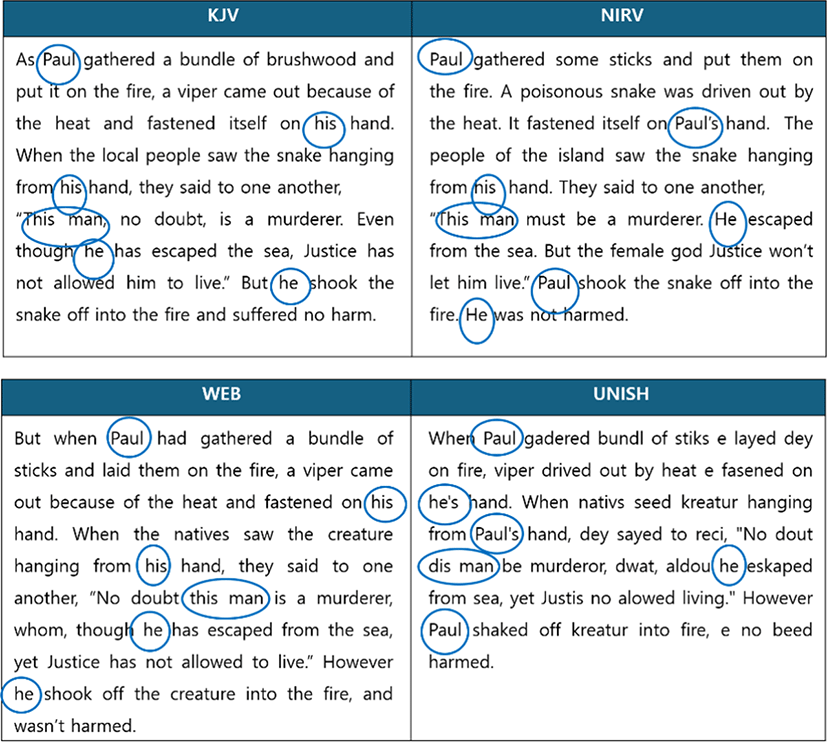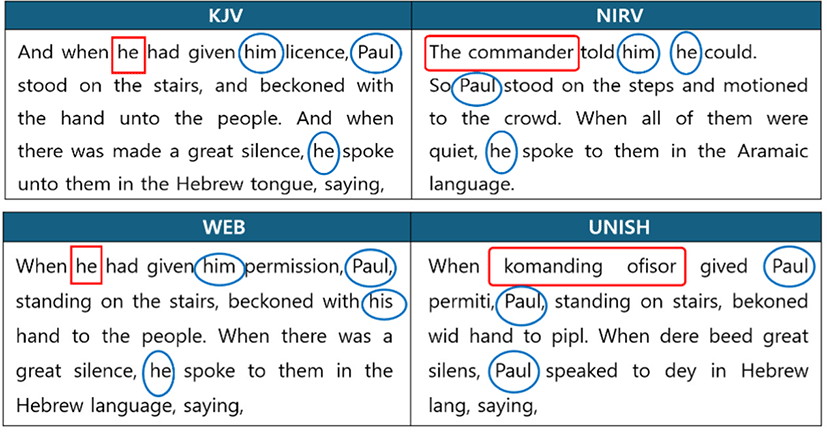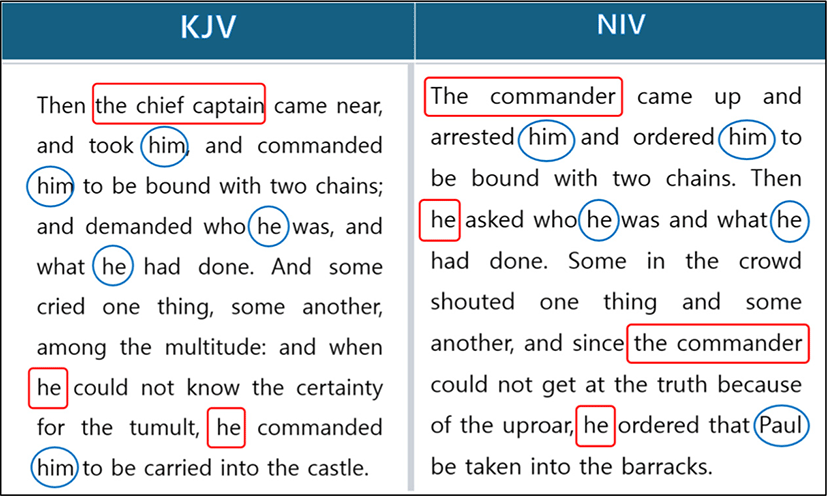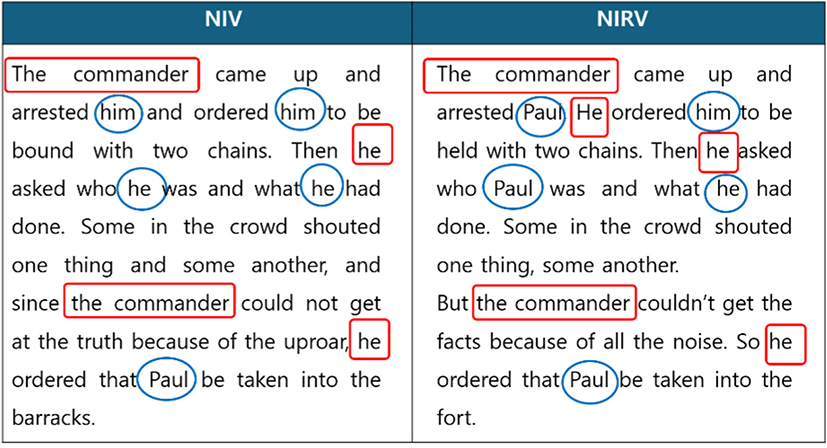1. Introduction
Pronoun systems vary significantly across languages, often leading to confusion for non-native English speakers when interpreting antecedent references (Roberts et al. 2008). Communication across linguistic boundaries has been a persistent challenge throughout human history, becoming increasingly vital as global interaction intensifies. While research confirms that pronoun resolution involves complex processes beyond simple syntactic relationships—incorporating event structure and discourse coherence (Rohde et al. 2006)—studies also highlight pronouns’ critical role in comprehension for both first and second-language speakers (Patterson et al. 2017). Despite these insights, research remains limited on how second-language speakers navigate pronoun ambiguity at the discourse level, particularly when multiple potential referents or distant antecedents obscure clarity.
AIALs1, designed for global communication, present a unique context for examining pronoun use. While AIALs prioritize regularity and simplicity, their impact on textual cohesion and ambiguity resolution remains underexplored. By examining translation strategies for native and non-native speakers, this study reveals how explicit noun repetition and pronoun-noun alternation improve readability and reduce cognitive load. The findings offer insights into pronoun ambiguity in both natural and artificial languages, with implications for translation studies, second-language acquisition, and AIAL development.
This study examines pronoun clarity challenges in English discourse through Bible translation analysis. It compares translations with distinct approaches: the formally equivalent KJV, the target reader-focused NIV, and the accessibility-oriented NIRV. Additionally, the research explores strategies for resolving pronoun ambiguity in artificial languages by analyzing Bible translation into Unish, an AIAL. The analysis employs paragraph-level cohesive chain methods.
This paper is organized as follows: Chapter 2 establishes a theoretical framework for analyzing pronoun functions and associated ambiguity issues in English discourse. Chapter 3 conducts a comparative analysis of Bible translations to evaluate various translation strategies and their effectiveness. Chapter 4 investigates pronoun-related challenges specific to artificial languages, while Chapter 5 focuses on strategies for ensuring pronoun clarity within AIALs, particularly examining Unish. Finally, Chapter 6 summarizes key findings and offers recommendations for future research.
2. The Role and Ambiguity of Pronouns in English Discourse
Pronouns are essential components of English grammar, serving to avoid redundancy and maintain cohesion within texts. They function as substitutes for specific nouns or noun phrases, allowing writers to refer back to previously mentioned entities without repetitive usage. This substitution enhances fluency and readability, making pronouns fundamental for efficient communication.
Pronouns contribute significantly to textual cohesion by linking different parts of a discourse. Cohesion is a crucial element in both the production and interpretation of discourse, and its effective application can be regarded as a key factor distinguishing successful communication from unsuccessful attempts (Tanskanen 2006: 27). According to Halliday and Hasan (1976), pronouns are considered grammatical cohesive devices as they create ties between sentences and paragraphs, thereby promoting coherence in both written and spoken texts. Furthermore, Hoey (1991) argues that pronouns, through their repetitive reference to discourse entities, exhibit characteristics akin to lexical cohesion.
Regardless of whether pronouns are classified as grammatical or lexical cohesive devices, their contribution to textual cohesion—and, by extension, coherence—depends on the principle of clear reference. Each pronoun must have an identifiable antecedent, ideally positioned close to the pronoun itself to prevent confusion. For instance, in the sentence, “Sarah gave her book to Emma because she needed it,” the pronoun “she” is ambiguous, potentially referring to either Sarah or Emma. Effective pronoun usage requires unambiguous connections to antecedents to ensure that readers can effortlessly follow the intended meaning.
Pronoun ambiguity arises when a pronoun could logically refer to more than one antecedent, leading to confusion for the reader. This issue is prevalent in complex sentences where multiple nouns of the same gender or number precede the pronoun. Such unclear references require readers to rely heavily on contextual clues, which can disrupt the reading flow and comprehension. This ambiguous pronoun issue, we believe, is particularly challenging in writing, where the producer of a text (the writer) and its receiver (the reader) are usually separated by both time and space.
According to Grice (1975), speakers and listeners cooperate to make conversations meaningful and efficient—that is, to achieve effective communication. This principle of cooperation is not limited to spoken interaction; it applies to writing as well. Linell (1988: 267) expands on this idea, noting that while collaborative efforts are more evident in the co-construction of conversations, they are not restricted to dialogue. Collaboration also manifests in writing and monologic discourse, where producers construct their topics and arguments sensitively to how potential consumers, or receivers, may react.
However, the timing of collaboration between producers and receivers differs between conversation and writing. Tanskanen (2006: 26) observes that “In dialogue, collaboration takes place in the here-and-now of the production of the conversation,” whereas “In monologic discourse, collaboration is realized at two stages: at the production stage, where the producer interacts with the implied receiver through mental representations, and at the interpretation stage, where the receiver can consider this collaboration and look for its signals in the message.”
Therefore, in conversational settings, when a listener does not understand the speaker’s message, they can—and are even encouraged to—immediately ask questions to resolve any ambiguities (English 2005). However, in written texts, the distance between the author and the reader—both temporal and physical—prevents the reader from directly seeking clarification from the author. As a result, the issue of ambiguous pronouns tends to be more problematic, or at least more significant, in written texts than in spoken interactions. Hence, writing experts recommend avoiding the use of ambiguous pronouns.
Clarity is essential in effective writing and communication. However, vague pronoun references often pose a challenge, leading to unclear and imprecise expressions. When pronouns lack clear antecedents or their references are ambiguous, the intended message can become confusing and difficult to follow. That is why ambiguous pronouns are considered an important and challenging issue not only in linguistics but also in Machine Translation and AI translation (Guillou 2012, Naveen & Trojovský 2024).
Pronouns possess lexical properties such as gender, number, and case, which function as cues to identify their antecedents. However, even when these cues are clear, ambiguity can still arise. Consider Toyka’s example (1992: 168):
Toyka explains that “he” could refer to either Amundsen or Scott, creating ambiguity. She suggests resolving this by using the specific name instead of the ambiguous pronoun “he,” as shown below (p. 168):
By using “Amundsen,” the ambiguity is resolved. To maintain clarity, one of the most effective methods is replacing ambiguous pronouns with explicit nouns. This approach, while potentially increasing redundancy, significantly enhances readability and comprehension, especially in complex texts. However, this strategy—repetition of a proper name instead of using a pronoun—can lead to increased reading times and cognitive load when overused, even if the referent is clear.
This effect, known as the RNP (Repeated Name Penalty), demonstrates that repeatedly using a proper noun instead of a pronoun can interrupt the natural reading flow and increase cognitive effort. Research by Gordon et al. (1993) indicates that although repeated names are clear, they disrupt readers’ expectations for pronoun usage when the referent is already prominent. Readers generally anticipate more concise and economical language, so encountering redundant proper names leads to additional cognitive processing to manage the excess information. Also, as Almor and Nair (2007) point out, names are generally employed to introduce new entities, so readers infer that the repetition carries additional significance and expend effort attempting to incorporate the redundant information.
In conclusion, while pronouns are indispensable for maintaining cohesion in texts, their potential for ambiguity necessitates careful attention. By employing clear referencing strategies, writers can enhance the clarity and effectiveness of their communication while balancing the need to avoid unnecessary repetition that may lead to the RNP effect.
3. Pronoun Usage and Clarity Issues in English Bible Translation
Ellington (2003) observes that section headings in modern Bible translations, while helpful for navigation, create pronoun reference problems. Readers who begin at these section breaks often encounter pronouns—such as he, she,orthey—without clear antecedents, forcing them to search backward in the text to identify the proper referents. Particularly, due to its large cast and complex narrative, Acts frequently uses pronouns, often causing referential ambiguity. Thus, we will examine pronoun usage in Acts across three major English translations: KJV, NIV and NIRV. Fee and Strauss (2007) classify the KJV as formal equivalence (word-for-word) and the NIV as dynamic equivalence (thought-for-thought). The NIRV, a simplified NIV adaptation, is designed for English learners and young readers to broaden its accessibility. The official NIRV website describes their relationship as follows:
And it makes the Bible accessible to new readers, and others who struggle with the English language…The words of the NIV are used by the translators wherever possible, but when the words of the NIV are difficult or have more than one meaning, different words are used that are easier to understand or the sentence is rephrased for clarity (NIV 2025).2
To systematically analyze pronoun usage—including additions, omissions, and nominal repetitions—this study employs a comparative cohesive chain analysis at the paragraph level. Baker (1992: 108) defines cohesion as “the network of lexical, grammatical, and other relations which provide links between various parts of a text.” Halliday and Hasan (1985) indicate identity chain, which refers to the same thing, event, attribute or relation, can be realized by devices of references such as the pronominals and demonstratives. This framework elucidates the sequential relationships between pronouns and their antecedents, highlighting patterns of cohesion and potential ambiguity. The comparison will be conducted as follows:
-
A comparative analysis of pronominal usage in the KJV and NIV, examining instances where pronouns may introduce ambiguity.
-
A subsequent comparison between the NIV and NIRV, investigating the strategies employed to mitigate ambiguity arising from pronominal references.
Grosz et al. (1995) acknowledge that to prevent ambiguity, a pronoun should refer to the most salient entity from the previous sentence. However, existing rules for maintaining discourse coherence remain incomplete, as they do not clearly specify which pronoun, in cases of multiple pronouns, links to the main topic of the preceding sentence. When the distance between a pronoun and its antecedent increases, their referential clarity can also be compromised. This section will discuss cases where pronouns create ambiguity, by using actual examples.
The following example (3), taken from Acts 21: 1 in the KJV and NIV, illustrates ambiguity arising from the distance between a pronoun and its antecedent. The passage describes Paul and his companions journeying from Ephesus toward Jerusalem, sailing through the Aegean islands and port cities. The “we” likely refers to Paul and Luke, the recorder of Acts, while “them” lacks a clear referent at the chapter opening, creating potential confusion for the readers.
Beginning a section with pronouns like “they” or “she” forces readers to search backward in the text to identify referents, which conflicts with translators’ expectation that readers will complete entire sections from start to finish (Ellington 2003). Verses in the sacred texts should be seen as “part of a larger sequence of mutually relevant elements or what we have been technically referring to as ‘text’3”. (Hatim & Mason 1997: 116). For a section to function as a complete text, pronouns and their corresponding referents must be clearly presented.
The NIRV, specifically designed for English as second language learners and younger readers, adopts a more explicit strategy, while KJV and NIV are crafted for native speakers, for whom contextual pronoun reference typically presents no significant comprehension barrier. It replaces the pronoun “them” with the specific noun phrase “the Ephesian elders” to ensure the referent clearly, as shown below:
Slabakova et al. (2017) propose that for second language learners, pronoun interpretation presents not primarily a grammatical challenge but rather a cognitive burden. As second language learners are more guided by lexical-semantic cues than by syntactic information during comprehension (Clahsen & Felser 2006), they may experience greater difficulties when processing extends beyond the text unit level. Consequently, translations like NIRV employ a strategic approach of using noun phrases to ensure the identification of consistent referents.
Figure 1, the passage from Acts 21: 33–34, illustrates pronoun ambiguity issues. When both the Roman commander and Paul are referred to as “he” in the same narrative, readers struggle to track who’s performing which actions.
The KJV creates confusion by using only pronouns after initially mentioning “the chief captain”. The NIV improves clarity by occasionally replacing pronouns with nouns (“the commander” or “Paul”), however, in sentences like “he asked who he was and what he had done,” the repeated pronouns still make it difficult to track who is who when both men appear in the same context. This example demonstrates a common translation challenge: balancing pronoun usage with explicit subject identification to maintain both readability and textual clarity.
When establishing dynamic equivalence or explicitly conveying implicit information in translation, nouns should often be used instead of pronouns when necessary to ensure clarity, especially in cases where pronominal reference may be ambiguous (Nida & Taber 1969, Wendland 2024). Furthermore, non-native speakers typically depend on immediate lexical cues, leading them to select the nearest or the most prominently highlighted noun phrase as the antecedent (Patterson et al. 2017).
A comparative analysis between the NIV and NIRV demonstrates how this approach significantly improves comprehension, particularly for second language learners.
In the NIRV translation of Acts 21, the commander and Paul are clearly distinguished by the frequent repetition of their names. Unlike the KJV, which does not reintroduce Paul at all, and the NIV, which reintroduces him only once, the NIRV repeats the name “Paul” even more than pronouns. For example, consider the sentence: “Then he asked who he was and what he had done.” The NIV uses the pronoun “he” for two different people, causing readers to look back to understand which he refers to Paul and which to the commander. In contrast, the NIRV clearly states “who Paul was,” removing ambiguity. This clarity through noun repetition is common throughout Acts 21, as shown in Table 1:
| Version | Occurrences |
|---|---|
| KJV | 12 |
| NIV | 18 |
| NIRV | 22 |
The NIRV’s higher use of the name Paul is intentional, aimed at improving readability. Ellington (2003) notes this strategy of replacing pronouns with nouns is increasingly common in modern translations. Pronouns help keep text concise, but repeating nouns helps prevent confusion, especially when multiple people are mentioned close together.
4. Pronouns in the International Auxiliary Language
Olsen (2003) classifies constructed or artificial languages into three categories: logical languages, international auxiliary languages, and fictional (or artistic) languages. Similarly, Goodall (2023) adopts a comparable framework but introduces an additional category, dividing them into philosophical languages, international auxiliary languages, languages for fiction, and languages designed for psycholinguistic experiments.
AIALs gained prominence in late 19th- and early 20th-century Europe, a period when no widely recognized lingua franca existed. Between 1850 and 1920, an average of three new constructed languages emerged annually, with over 150 introduced during the particularly active period from 1886 to 1916 (Goodall 2023: 421, based on Okrent 2009). This surge was largely driven by the aspiration to create a common auxiliary language that could bridge linguistic divides.
AIALs developed during this time were intended to differ from natural languages in one key aspect: “Adults should be able to learn them in a short time” (Goodall 2023: 421). Renowned linguist Max Müller asserted that an artificial language is not only possible but could also surpass natural languages in terms of “perfection, regularity, and ease of learning” (Talmey 1923: 345). Likewise, the esteemed philologist Jacob von Grimm outlined key requirements for a successful universal language, emphasizing that it must be “exceptionally easy to learn, write, and speak” (Talmey 1923: 346).
Regularity and ease of learning were, of course, also central to the success of the most widely adopted AIAL, Esperanto. Its creator, L. L. Zamenhof, believed that people could begin using Esperanto with minimal formal study. To demonstrate this, he encouraged individuals to write to foreign friends in Esperanto, enclosing a small leaflet containing basic root words and affixes. He anticipated that recipients would be able to understand and use the language with little effort, showcasing its practicality and ease of acquisition (Okrent 2009: 103).
By the end of World War II, interest in international auxiliary languages had declined significantly. Among the various contributing factors, one major reason was the emergence of English as the most dominant international language in history (Okrent 2009: 135–136). However, this development also led to a new issue: inequity. Artificial languages have no native speakers, making them ideal as universal languages since they do not grant any particular group a linguistic advantage. In contrast, native English speakers automatically enjoy privileges in an English-dominated world due to their natural fluency (Choo 2001).
As a result, while not as widely discussed or developed as in the past, artificial languages continue to be explored as potential international auxiliary languages. In these languages, ease of learning —one of the essential conditions for an effective international common language (Lee 2001: 51)—remains a crucial factor. Additionally, regularity and simplicity are consistently presented as key features to ensure ease of learning.
Almost all artificial languages claim that they are easy to learn and use because they are regular and simple. The ultimate goal of these artificial languages is to overcome language barriers and facilitate successful communication. However, effective communication depends not only on regularity, simplicity, and ease of learning and use but also, as discussed in Section 2, on clarity.
Discussions on artificial languages can largely be categorized into two main types. The first consists of works by artificial language inventors or their followers, who introduce these languages and promote their advantages. The second involves academic approaches to artificial languages, including (i) chronological studies on their historical development and the characteristics of each era (Okrent 2009, Goodall 2023), (ii) evaluations of their potential success as international languages (Libert 2012, 2013; Gobbo 2020), (iii) analyses of their necessity and significance (Gobbo 2005, Maat 2016, Chin 2023, Park 2023), (iv) comparisons with natural languages or other artificial languages (Lee 2002; Kwak 2003; Moskovsky & Libert 2004, 2009; Gobbo 2011, 2017), and (v) studies on their grammar, pronunciation, spelling, and vocabulary (Libert & Moskovsky 2011; Libert 2012, 2013) and so on.
However, studies that approach artificial languages at the discourse and text levels are rare. Furthermore, regarding the topic of this paper—pronouns in artificial languages—most research is limited to a brief introduction of their forms, with little attention given to their role in textual cohesion and coherence.
Although studies on the issue of pronoun ambiguity and its solutions in artificial languages are difficult to find, research on relative pronouns has been conducted. While pronouns and relative pronouns differ in several significant ways, they share key characteristics: (i) both function to refer to a previously mentioned entity, i.e., an antecedent; (ii) both are ideally placed close to their antecedent to minimize confusion; and (iii) both can create ambiguity when multiple noun phrases could serve as the antecedent. Therefore, examining the ambiguity of relative pronouns can provide valuable insights into the broader discussion of pronoun ambiguity in texts written in artificial languages.
Moskovsky and Libert (2009: 73) analyze relative clauses and relative pronouns in artificial languages, highlighting that ambiguity arises when a relative pronoun has more than one possible antecedent noun phrase. They identify two strategies used in artificial languages to resolve such ambiguity. One approach is to incorporate agreement marking for number, humanness, gender, or animacy on relative pronouns. The other strategy, introduced by Russell (1966: 4–5), the creator of the artificial language Suma, involves repeating the antecedent instead of using a relative pronoun. For example, in Suma:
If there is ambiguity, repeat the antecedent in place of sio:
Ambiguous: papo dea kato, sio te tila (father of the boy who is sick? The father or the boy?)4
Unambiguous: papo dea kato, tu kato te tila (father of the boy, this boy is sick);
papo dea kato, tu papo te tila (father of the boy, this father is sick)
Russell explains that in cases of ambiguity, replacing the relative pronoun sio with the repeated antecedent noun ensures clarity. While this method slightly compromises the simplicity often valued in artificial languages, it enhances precision by explicitly identifying the intended referent. Given that relative pronouns and personal pronouns share common characteristics, strategies for resolving ambiguity in relative pronouns in artificial languages can also offer valuable insights into addressing pronoun ambiguity more broadly in these languages.
Among artificial languages, this paper focuses primarily on analyzing Unish. Unish is a modern international auxiliary language designed to overcome the limitations of existing linguistic models. The name “Unish” is derived from “Universal Language,” and its development has been ongoing at Sejong University in Korea since 1995. Researchers at Sejong University initiated this project intending to create a language that emphasizes regularity and incorporates common features of both natural and artificial languages, thereby facilitating ease of acquisition (Kwak 2003).
To date, Unish has built a lexicon of approximately 15,100 words, selecting vocabulary from 14 natural languages—including Arabic, Chinese, French, German, Greek, Hindi, Italian, Japanese, Korean, Latin, Portuguese, Russian, and Spanish—as well as one artificial language, Esperanto. Its grammar is structured around principles of simplicity, logic, and consistency to enhance ease of learning and use (Choo 2001, Lee 2002, Park & Chin 2020, Tak 2020). Although Unish has not yet formed a speech community, it continues to be refined through the consistent publication of New Testament translations.
As shown in Table 2, Unish personal pronouns share some formal similarities with English personal pronouns.
However, Unish pronouns are more concise than their English counterparts (e.g., u–you, dey–they), and their subject and object forms are identical. Additionally, personal pronouns expressing possession follow the same pattern as regular nouns by taking “-s,” while reflexive pronouns consistently use “-self” regardless of number, making the system more regular.
In the next section, we will compare the Unish Bible with English Bibles and analyze how pronouns function in artificial and natural language translation.
5. Comparative Analysis of Pronoun Usage in English and Unish
Although AIAL learning typically occurs in controlled, experimental settings and second language learning involves broader social and contextual factors, both processes share underlying cognitive mechanisms, such as implicit learning (Robinson 2010, Ettlinger et al. 2016, Culbertson & Schuler 2019). Both NIRV, which targets English learners and young readers, and Unish as an AIAL are premised on the notion that their mechanisms align closely with those employed by second-language learners. Therefore, the comparison of NIRV and Unish with the KJV and WEB aims to analyze the strategies each translation employs to achieve clarity within their pronoun systems.
This section examines how AIALs address pronoun ambiguity by comparing the English Bible translations (KJV, NIRV, WEB) and the Unish Bible (Gu et al. 2024). Unish adopts the WEB as its source text for Bible translation. The WEB, based on the ASV, prioritizes fidelity to the source text (Perry & Grubbs 2020). In contrast, the NIRV and Unish emphasize clarity for their target audiences.
Figure 3 illustrates Acts 28: 1–5, where Paul is shipwrecked on Malta and bitten by a viper. The KJV and WEB construct Paul’s cohesive chain primarily through pronouns:

Excluding this man as noun phrase, the rest of the references form a cohesive chain using pronouns. In contrast, NIRV and Unish employ lexical devices more often than pronuns:
While matching pronouns to their antecedents is generally straightforward for adult native speakers of English (Patterson et al. 2017, Slabakova et al. 2017), English third-person singular possessive determiners (his and her) often pose significant challenges for learners whose first languages employ different morpho-syntactic systems for expressing possession (White et al. 2007). This pronoun ambiguity primarily affects second language learners, young readers, and learners of artificial languages, which are deliberately learned rather than naturally acquired. To address this challenge, Unish employs a strategy of noun repetition instead of using potentially ambiguous pronouns, thereby enhancing textual clarity.
Figure 4 presents Acts 21: 40, where Paul addresses a crowd after being seized by an angry mob.

Different translations handle referencing characters in Acts 21: 40 in distinct ways. The KJV and WEB translations rely completely on pronouns to maintain cohesion when referring to both Paul and the commanding officer. In contrast, NIRV and Unish use nouns for clarity, but with different approaches:
While the NIRV mentions Paul’s name once before switching to pronouns, Unish consistently repeats “Paul” to avoid any ambiguity about the referent. This approach is particularly beneficial for language learners, who tend to struggle more with accuracy when a full pronoun is used with a referent (Slabakova et al. 2017). Non-native speakers rely more on surface-level lexical cues than on complex information structures when resolving pronoun references (Felser et al. 2003, Wendland 2024).
The phenomenon of pronoun resolution has been extensively investigated in linguistic research, particularly regarding first language influence (Roberts et al. 2008), challenges associated with multiple potential antecedents (Contemori et al. 2019), and cognitive processing as evidenced by pupil dilation (Vogelzang et al. 2016). Notably, Chow et al. (2014) demonstrated that pronoun interpretation extends beyond grammatical rules to incorporate discourse-level cohesion and readers’ cognitive processing mechanisms. While critics may argue that noun repetition potentially increases cognitive load, achieving optimal clarity in discourse requires comprehensive analysis of pronoun strategies in artificial languages rather than focusing exclusively on grammatical conventions. Wendland (2024) particularly stresses that clear pronoun reference is essential in theological writing, recommending noun substitution where antecedents might confuse non-native readers or complicate translation. When translating the Bible, Unish aimed for clarity by repeating nouns instead of using pronouns or leaving out pronouns when the owner was clear. Unish’s approach solves two potential problems. First, since Unish doesn’t distinguish between nominative and objective cases, using all pronouns would create confusing sentences like “when he gave he permit, he....” Second, in translating “Paul bekond wid hand,” Unish omits the possessive “his,” recognizing that readers can easily understand whose hand is being referenced. This approach values communicative equivalence over grammatical accuracy in pronoun usage, matching with the goals of artificial languages.
6. Conclusion
As demonstrated throughout this comparative analysis of Bible translations, effectively managing pronoun-antecedent relationships is crucial for minimizing cognitive load and enhancing clear communication, particularly for non-native speakers. The examination of pronoun usage across KJV, WEB, NIRV, and Unish Bible translations reveals distinct strategic approaches to maintaining textual cohesion while avoiding ambiguity.
The Unish approach to pronoun usage values communicative equivalence over strict grammatical adherence, reflecting the fundamental purpose of AIALs—to facilitate clear understanding across linguistic boundaries. These findings suggest that when designing artificial languages intended for international communication, discourse-level considerations should be given as much weight as grammatical regularity.
Future research should continue to examine pronoun strategies in artificial languages beyond isolated grammatical descriptions, focusing instead on their functional effectiveness in maintaining textual cohesion and coherence in actual discourse contexts.









